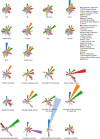Topics and trends in artificial intelligence assisted human brain research
- PMID: 32251489
- PMCID: PMC7135272
- DOI: 10.1371/journal.pone.0231192
Topics and trends in artificial intelligence assisted human brain research
Abstract
Artificial intelligence (AI) assisted human brain research is a dynamic interdisciplinary field with great interest, rich literature, and huge diversity. The diversity in research topics and technologies keeps increasing along with the tremendous growth in application scope of AI-assisted human brain research. A comprehensive understanding of this field is necessary to assess research efficacy, (re)allocate research resources, and conduct collaborations. This paper combines the structural topic modeling (STM) with the bibliometric analysis to automatically identify prominent research topics from the large-scale, unstructured text of AI-assisted human brain research publications in the past decade. Analyses on topical trends, correlations, and clusters reveal distinct developmental trends of these topics, promising research orientations, and diverse topical distributions in influential countries/regions and research institutes. These findings help better understand scientific and technological AI-assisted human brain research, provide insightful guidance for resource (re)allocation, and promote effective international collaborations.
Conflict of interest statement
The authors have declared that no competing interests exist.
Figures






Similar articles
-
Modeling Research Topics for Artificial Intelligence Applications in Medicine: Latent Dirichlet Allocation Application Study.J Med Internet Res. 2019 Nov 1;21(11):e15511. doi: 10.2196/15511. J Med Internet Res. 2019. PMID: 31682577 Free PMC article.
-
Artificial intelligence applications and aging (1995-2024): Trends, challenges, and future directions in frailty research.Arch Gerontol Geriatr. 2025 Jul;134:105837. doi: 10.1016/j.archger.2025.105837. Epub 2025 Mar 25. Arch Gerontol Geriatr. 2025. PMID: 40168925
-
Analysis of international publication trends in artificial intelligence in ophthalmology.Graefes Arch Clin Exp Ophthalmol. 2022 May;260(5):1779-1788. doi: 10.1007/s00417-021-05511-7. Epub 2022 Jan 9. Graefes Arch Clin Exp Ophthalmol. 2022. PMID: 34999946 Review.
-
The Current Research Landscape of the Application of Artificial Intelligence in Managing Cerebrovascular and Heart Diseases: A Bibliometric and Content Analysis.Int J Environ Res Public Health. 2019 Jul 29;16(15):2699. doi: 10.3390/ijerph16152699. Int J Environ Res Public Health. 2019. PMID: 31362340 Free PMC article.
-
A Bibliometric Perspective on AI Research for Job-Résumé Matching.ScientificWorldJournal. 2022 Oct 3;2022:8002363. doi: 10.1155/2022/8002363. eCollection 2022. ScientificWorldJournal. 2022. PMID: 36225947 Free PMC article. Review.
Cited by
-
A one-hundred-year structural topic modeling analysis of the knowledge structure of international management research.Qual Quant. 2022 Oct 10:1-31. doi: 10.1007/s11135-022-01548-w. Online ahead of print. Qual Quant. 2022. PMID: 36249708 Free PMC article.
-
The evolution and future of diabetic kidney disease research: a bibliometric analysis.BMC Nephrol. 2021 Apr 29;22(1):158. doi: 10.1186/s12882-021-02369-z. BMC Nephrol. 2021. PMID: 33926393 Free PMC article.
-
Machine and cognitive intelligence for human health: systematic review.Brain Inform. 2022 Feb 12;9(1):5. doi: 10.1186/s40708-022-00153-9. Brain Inform. 2022. PMID: 35150379 Free PMC article. Review.
-
Dose Correlation of Danggui and Chuanxiong Drug Pairs in the Chinese Medicine Prescription Based on the Copula Function.Evid Based Complement Alternat Med. 2020 Nov 20;2020:2372746. doi: 10.1155/2020/2372746. eCollection 2020. Evid Based Complement Alternat Med. 2020. PMID: 33273949 Free PMC article.
-
A scholarly network of AI research with an information science focus: Global North and Global South perspectives.PLoS One. 2022 Apr 15;17(4):e0266565. doi: 10.1371/journal.pone.0266565. eCollection 2022. PLoS One. 2022. PMID: 35427381 Free PMC article.
References
-
- Turing A. Mind. Mind. 1950;59(236):433–60.
-
- Ullman S. Artificial intelligence and the brain: computational studies of the visual system. Annual Review of Neuroscience. 1986;9(1):1–26. - PubMed
Publication types
MeSH terms
LinkOut - more resources
Full Text Sources
Miscellaneous

